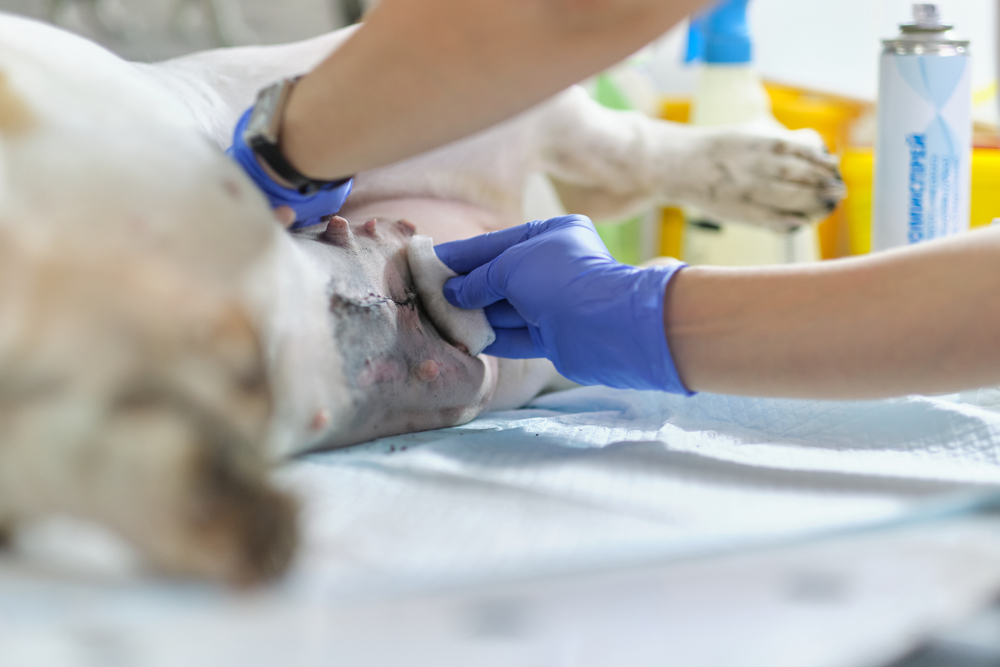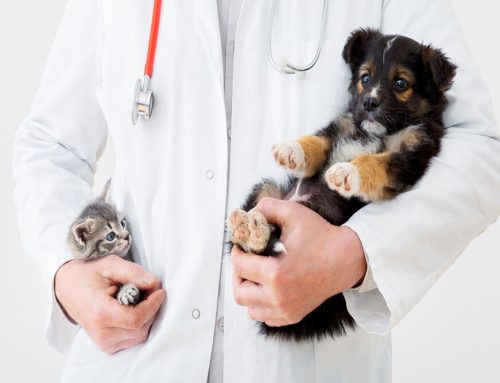Pyometra is a serious uterine condition that occurs most commonly in older, intact (i.e., unspayed) female dogs. However, pyometra can also affect unspayed cats, hamsters, ferrets, guinea pigs, rats, and rabbits of any age. Pyometra is a life-threatening—but preventable—condition that our Providence Vet team wants you to learn about, so you can help your female pet avoid this reproductive emergency. Learn pyometra’s causes, signs, treatment, and prevention.
What causes pyometra in pets?
The body’s natural hormonal (i.e., progesterone and estrogen) uterine changes can cause an intact female pet to develop pyometra, causing their uterus to fill with pus. While all intact female pets can experience pyometra, the condition is most common in pets older than age 6. Intact female pets will have their first estrous (i.e., reproductive or heat) cycle when they reach puberty. Each cycle comprises several stages, including the estrus phase (i.e., heat), when a female can become pregnant. During a heat cycle, hormone fluctuations trigger the uterus to prepare for pregnancy. After a heat cycle—when the uterus lining thickens and the cervix opens the urogenital tract to ascending bacteria—a pet is at risk of developing a pyometra infection. Pyometra’s two types include:
- Open — In an open pyometra, the cervix—the entry to the uterus—remains open, and pus, blood, or discharge drains from your pet’s vulva. An open cervix creates a channel to the outside.
- Closed — When the cervix is closed, rather than visible discharge, your pet’s abdomen swells or distends as a result of the uterus filling with fluid. A closed pyometra traps the bacteria inside a pet’s uterus. The bacteria continuously multiply, releasing toxins into an affected pet’s bloodstream. A pet with a closed pyometra may become ill rapidly, as bacterial toxins in the bloodstream impair organ function.
What are pyometra signs in pets?
To ensure your female pet receives immediate veterinary care if you suspect they have this condition, you should learn to recognize pyometra signs. Some pets—especially cats—may show no signs or have only mild vaginal discharge or abdominal swelling. Because of the delayed onset of visible signs, detecting pyometra in the disease’s early stages is nearly impossible, and by the time your pet exhibits signs—between 4 and 8 weeks after their heat cycle—the condition is usually quite advanced. Pyometra’s signs may include:
- Lethargy
- Excessive thirst and urination
- Depression
- Pale gums
- Appetite loss
- Bloody or milky vaginal discharge
- Vomiting
- Diarrhea
- Abdominal swelling or pain
If you notice any of these signs, immediately contact your veterinarian. Early intervention can minimize complications and increase the likelihood that your veterinarian can save your pet’s uterus.
How is pyometra diagnosed in pets?
If your veterinarian suspects your pet has pyometra, they will first perform a thorough physical examination, noting signs such as vaginal discharge and abdominal distention. Your veterinarian may also take X-rays and perform an ultrasound, which can help measure your pet’s uterine wall thickness and detect fluid accumulation. To identify infection and inflammation that correspond with increased bacteria, your veterinarian may also recommend your pet undergo other diagnostic testing, including:
- Blood work
- Urinalysis
- Vaginal cytology

How is pyometra treated in pets?
The most common pyometra treatment is a spay surgery (i.e., ovariohysterectomy), to remove the infected uterus and the ovaries. Spaying your pet eliminates the infection source and prevents future pyometra infections. A pyometra surgery is more complicated than a routine spay, introducing a greater complication risk and requiring extended hospitalization. Despite the risks, spaying is the preferred treatment for pyometra.
A nonsurgical alternative for open pyometra treatment is available for breeding, working, or show pets. This treatment involves an antibiotic course, and hormone administration to stimulate uterine contractions to expel the infected contents. However, keep in mind that this treatment option can cause serious side effects, such as a uterine rupture, and pets have a high pyometra recurrence risk.
How can pyometra be prevented in pets?
Pyometra is a serious and life-threatening condition, but the good news is that this condition is entirely preventable when you have your pet spayed at a young age. This surgery helps protect your pet from pyometra and other reproductive diseases such as mammary cancer.
Intact female pets are at risk for developing pyometra—a life-threatening uterine condition. Protect your pet from this devastating but preventable disease by scheduling your female pet’s spay surgery with our Providence Vet team.






Leave A Comment